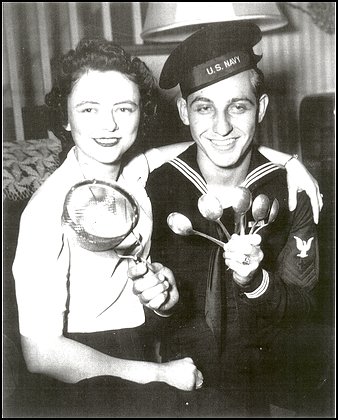|
Wheeler Lipes
Dies
Did Emergency Surgery While on Sub
By Adam Bernstein
Washington Post Staff Writer
Tuesday, April 19, 2005; Page B06
Wheeler "Johnny" Lipes, 84, a Navy pharmacist's mate who performed a remarkable, improvised appendectomy during a World War II submarine run 120 feet under the Pacific Ocean, died April 17 at a hospital in New Bern, N.C. He had pancreatic cancer.
Lipes, who retired as a lieutenant commander, was a 22-year-old high school dropout at the time of his surgical feat in 1942. The Lipes legend was chronicled in a Pulitzer Prize-winning news account, provided a surge of morale during a period of desperately bad news from the Pacific and helped inspire a wartime action film starring Cary Grant.
|
 |
|
Wheeler Lipes was a pharmacist's mate when he did an appendectomy. |
Doctors were not assigned to submarines at the time; instead, the medical work was left to such independent duty corpsmen as Cmdr.
Lipes. He led the first of three successful surgeries by submarine corpsmen during the war but was ostracized by Navy Medical Corps physicians. They were angered by his actions, even though he had been obeying his captain's orders. There also was talk of a court-martial by the outraged U.S. surgeon general, who was forced to set protocols for appendectomies on submarines.
Cmdr. Lipes was the only medical professional aboard the submarine Seadragon on Sept. 11, 1942, when seaman Darrell Rector, 19, began complaining about a pain in his stomach and asked for laxatives. Cmdr. Lipes examined Rector and determined that his appendix was about to burst, but he was reluctant to work on him.
The Seadragon's captain, knowing they were in the hostile South China Sea and days from home port in Fremantle, in western Australia, ordered Cmdr. Lipes to collect a team of helpers and use whatever supplies he could find.
He converted a dining table in the ward room into an operating table. Bent tablespoon handles became retractors to hold open the incision and abdominal muscles. Aides poured ether on gauze and placed the gauze over a tea strainer to act as an anesthesia mask over Rector's mouth.
They sterilized all instruments with boiling water. They used "torpedo juice," alcohol usually reserved for fueling the Seadragon's torpedoes, to kill germs in the pajamas that substituted for surgical clothing.
As he started the procedure, Cmdr. Lipes used the McBurney's point, the most tender area of the abdomen of patients in the early stage of appendicitis, to locate the inflamed appendix. He made his incision, but the appendix did not pop up as expected. Looking around, he found it a massive five-inches long and stuck to three places on the lining of the intestine, which, if it broke, would pour pus into the abdomen and kill the patient. Part of the appendix was gangrenous.
Wielding a scalpel blade -- he lacked the full scalpel -- he gently removed the appendix while wafts of ether filled the cabin.
The operation, which was successful, lasted 2 1/2 hours. The Seadragon, noting its record at sea, sent an eye-catching message back to base: "One Merchant Ship, One Oil Tanker and One Successful Appendectomy."
News spread through the prize-winning story in the Chicago Daily News. The film "Destination Tokyo" (1943), starring Cary Grant as the skipper, also featured a submarine appendectomy that paralleled the events aboard the Seadragon -- except the surgery was performed beneath Tokyo Bay for added drama.
Rector returned to duty but perished two years later aboard the submarine Tang, whose launched torpedo circled back and hit the vessel.
Wheeler Bryson Lipes was born July 12, 1920, in New Castle, Va., near Roanoke. "Somewhere on my mother's side there were a couple of doctors in the family, but the branch I came from didn't have much going except peanuts," he once said.
He helped his divorced mother, who did nursing home work for Navy personnel in the Norfolk area. As a teenager, he worked at a Norfolk naval hospital serving meals to patients, helping in the pharmacy and typing patient records.
He joined the Navy at age 16, later receiving a high school diploma through a GED program and attending George Washington University.
After training as a pharmacist's mate, he was transferred in 1940 to the Philippines. While he was serving on the submarine Sealion, the ship was hit by Japanese bombs during an attack on Cavite Naval Yard on Dec. 10, 1941. Cmdr. Lipes suffered minor injuries -- "That's where I got this extra part in my hair" -- and he became the new pharmacist's mate aboard the Seadragon.
In 1951, Cmdr. Lipes was commissioned an ensign in the Navy's Medical Service Corps. He attended the Naval Justice School in Newport, R.I., and participated in defense work in court-martial proceedings.
His final active-duty assignment, in 1962, was as a finance officer at the naval hospital in Memphis. He did hospital administration work in Tennessee before retiring in 1991 as president of Memorial Medical Center in Corpus Christi, Tex.
His military decorations included the Purple Heart. More recent lobbying by Navy historians led to his receiving the Navy Commendation Medal in February at a ceremony at Camp Lejeune, N.C.
His first wife, Myrtle Peterson Lipes, whom he married in 1939, died in 1997.
Survivors include his wife, Audrey Lipes of New Bern; a stepson who took his surname, Bruce Lipes of Corpus Christi; four grandchildren; and four great-grandchildren.
Cmdr. Lipes once flew to Chicago for a meeting of the American Hospital Association. Next to him a man was looking incredulously at a "Ripley's Believe It or Not!" sketch, which showed the submarine appendectomy and the spoons used.
"He looked at me with a strange look on his face," Cmdr. Lipes recalled, "and said, 'Do you believe that?' And I said to him, 'I wouldn't believe a word of it.' "
